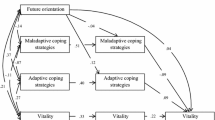Abstract
Adolescent future orientation was studied from the point of view of orienting expectations about the future, consisting of three aspects: cognitive (clarity of plans for the use of future time), affective (optimistic vs pessimistic attitudes toward the future), and motivational (realistic vs unrealistic wishes for the future). The study was part of the Jyväskylä Longitudinal Study of Social Development, the original sample for which consisted of 8-year-old subjects. Follow-up studies were made using a semistructured interview covering several aspects of home atmosphere (child-rearing and external home conditions) and youthful life orientation at ages 14 and 20 with 115 subjects. Results obtained with LISREL confirmed the hypothesis that optimism toward the future at age 20 was related to positive memories of child-rearing, and to a degree the hypothesis that the clarity of plans was related to parental occupational status and working conditions. Memory of the parents’ time for the child explained all aspects of adolescent future orientation.
Résumé
L’orientation des adolescents vers le futur a été examinée du point de vue de la direction des attentes selon trois aspects: cognitif (la clarté des projets concernant le futur), affectif (les attitudes optimistes ou pessimistes envers le futur) et motivationnel (les désirs réels ou irréels envers le futur). Les recherches présentées constituent une partie du projet «Jyväskylä Longitudinal Study of Social Development», qui portait initialement sur des enfants âgés de huit ans. Les recherches ont été reprises avec des sujets de 14 et 20 ans en utilisant cette fois des entretiens pour faire évoquer quelques aspects de l’atmosphère familiale (les façons d’élever les enfants et les conditions extérieures) ainsi que l’orientation adolescente envers la vie. En utilisant LISREL on a obtenu des résultats qui confirment l’hypothèse suivante: l’optimisme envers le futur chez les jeunes âgés de 20 ans est lié aux souvenirs positifs concernant l’éducation familiale. Ces résultats ont confirmé aussi dans une certaine mesure une deuxième hypothèse: la clarté des projets concernant la vie est liée au statut professionnel des parents et à leurs conditions de travail. En effet, le souvenir du temps que les parents consacraient à l’enfant est en relation avec tous les aspects de l’orientation adolescente vers le futur.
Similar content being viewed by others
References
Agarwal, A., Tripathi, K. K., & Srivastava, M. (1983). Social roots and psychological implications of time perspective.International Journal of Psychology, 18, 367–380.
Atkinson, J. W. (1964).An introduction to motivation. Princeton, N. J.: Van Nostrand.
Bandura, A. (1977).Social learning theory. New Jersey: Prentice-Hall.
Blinnikka, L.-M. (1977). Ihmisen aikaperspektiivi ja tulevaisuuden kuva. (Time perspective and the image of the future. Finn.).Psychological Research Reports. University of Turku, Finland. Whole Nr. 27.
Blinnikka, L.-M. (1982). Aikaperspektiivi ja tulevaisuuden kuva aikuisiällä. (Time perspective and the image of the future in adulthood. Finn.).Psychological Research Reports. University of Turku, Finland. Whole Nr. 60.
Bouffard, L., Lens, W., & Nuttin, J. R. (1983). Extension de la perspective temporelle future en relation avec la frustration.International Journal of Psychology, 18, 429–442.
Cartron-Guerin, A., & Levy, P. (1980). Achievement and future time perspective among preadolescents: Range, nature, and optimism of future plans.Bulletin de Psychologie, 33, 747–753.
De Volder, M. L., & Lens, W. (1982). Academic achievement and future time perspective as a cognitive-motivational concept.Journal of Personality and Social Psychology, 42, 566–571.
Gjesme, T. J. (1979). Future time orientations as a function of achievement motives, ability, delay of graiification, and sex.Journal of Psychology, 101, 173–188.
Havighurst, R. J. (1955).Human development and education. New York: Longmans.
Jöreskog, K. G., & Sörbom, D. (1979).Advances in factor analysis and structural equation models. Cambridge, Mass.: Abt Books.
Lahikainen, A. R. (1984). Tyottomyys, mielenterveys ja tyollisyyskoulutus. (Unemployment, mental health and retraining. Finn.) Research Reports from the Department of Social Psychology, University of Helsinki, Finland. Whole Nr. 1.
Mönks, F. (1968). Future time perspective in adolescents.Human Development, 11, 107–123.
Nurmi, J.-E. (1983). Nuorten tulevaisuuden suuntautuminen. (Future orientation in adolescence. Finn.). Psychological Research Reports, University of Turku, Finland. Whole Nr. 67.
Pulkkinen, L. (1982). Self-control and continuity from childhood to late adolescence. In P. B. Baltes & O. G. Brim Jr. (Eds.),Life-span development and behavior (pp. 63–105). Vol. 4. New York: Academic Press.
Pulkkinen, L. (1983a). Finland: Search for alternatives to aggression. In A. P. Goldstein & M. Segall (Eds.),Aggression in global perspective (pp. 104–144). New York: Pergamon Press.
Pulkkinen, L. (1983b). Youthful smoking and drinking in a longitudinal perspective.Journal of Youth and Adolescence, 12, 253–283.
Pulkkinen, L. (1987). Zukunftsorientierung bei Jugendlichen zur Multidimensionalität und Multidirektionalität der psychischen Entwicklung.Psychologie in Erziehung und Unterricht, 34, 20–32.
Trommsdorff, G. (1983). Future orientation and socialization.International Journal of Psychology, 18, 381–406.
Trommsdorff, G. (1986). Future time orientation and its relevance for development as action. In R. K. Silbereisen, K. Eyferth & G. Rudinger (Eds.),Development as action in context: Problem behavior in normal youth development (pp. 121–136). Berlin: Springer-Verlag.
Verstaeten, D. (1980). Level of realism in adolescent future time perspective.Human Development, 23, 177–191.
Author information
Authors and Affiliations
Rights and permissions
About this article
Cite this article
Pulkkinen, L. Home atmosphere and adolescent future orientation. Eur J Psychol Educ 5, 33–43 (1990). https://doi.org/10.1007/BF03172767
Revised:
Issue Date:
DOI: https://doi.org/10.1007/BF03172767




